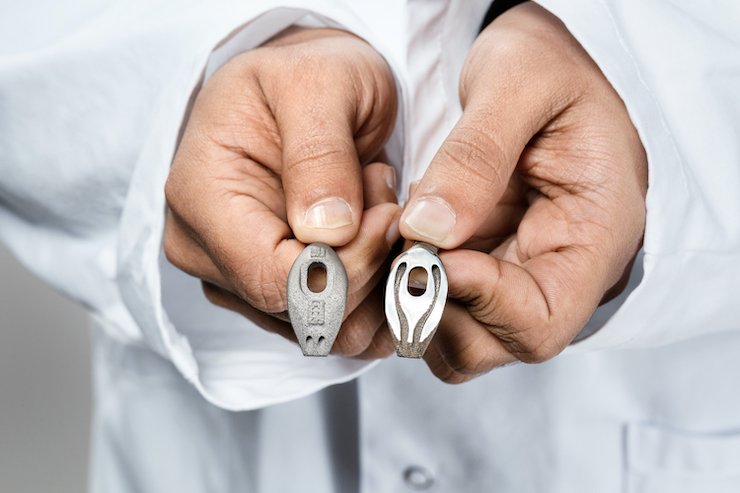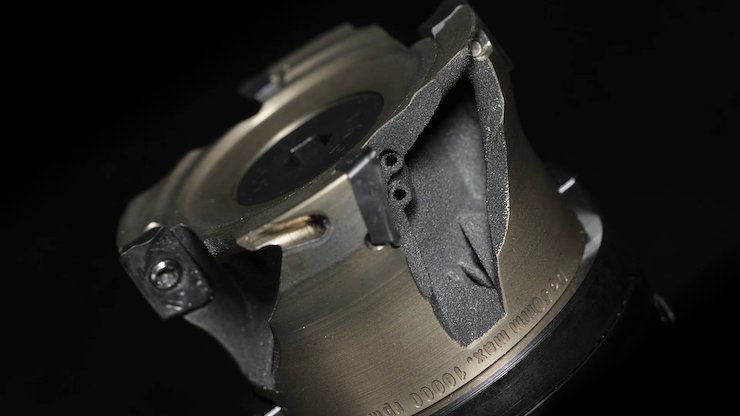
Through a recently announced, ring-fenced collaboration, Sandvik and GE Additive set out a very specific materials roadmap for the latter’s H2 Binder Jetting system. It has been driven by the demands of its partner’s end-users and designed to facilitate series industrial applications.
The details, for now at least, remain behind firmly closed lips, but Sandvik’s general additive manufacturing (AM) strategy has been made very clear.
For more than 15 years, the Swedish firm has been working alongside AM users to deliver metal powder solutions and, since 2013, has made sizeable investments into a wide range of AM technologies. It houses Powder Bed Fusion, Electron Beam Melting and Binder Jetting machines; boasts nine gas atomisation towers to support its metal powder production; and, in the last couple of years, has slammed on the accelerator as it establishes itself as a leading metal AM powder supplier.
While a smash-proof guitar made from 3D printed titanium and machined stainless steel proved an effective marketing tool last year, through materials collaborations with GE, ExOne and Renishaw; investments in the BEAMIT and Zare service bureaus; and the securing of ISO 13485:2016 and AS9100D certifications, Sandvik has been prolific in getting things done. The developments of the last 24 months all serve to supplement its 3D printing powder production plants in Sandviken, Sweden and Neath, UK, and continue the traditions of a company founded in the 1860s.
“It builds on the heritage, DNA and approach that Sandvik has had over its 158-year history, driving materials evolution,” Keith Murray, VP & Head of Global Sales at Sandvik AM, tells TCT. “In that time, it has been successful through innovation and diversifying into new and different areas, continuously launching new materials. The interest in additive is driven by the same thing.”
Having stepped up its presence in AM through an R&D centre several years ago, Sandvik expanded its play in the sector gradually by plugging gaps in its product portfolio. Titanium and aluminium were the biggest of those gaps and have since been addressed by material-specific production sites set up in Sweden and the UK, respectively. With these metals complementing its tool steels, maraging steels, stainless steels, duplex and superduplex steels, nickel-based superalloys, cobalt alloys and copper alloys, Sandvik believes it has the broadest range of metal AM powders out there. What’s more, it has control over every step of their development, from raw materials through gas atomisation and all the downstream processes.
To build quality into the part, you have to build quality into the processes.
The company has decades’ worth of gas atomisation experience and considers it the most commonly used production method of metal additive powders for a reason. “It is inherently strong in producing spherical particles and flow is one of the fundamental characteristics that the powder has to have,” Murray explains, before detailing how the secondary steps of sizing and screening metal powders help to ensure the required particle size distribution for the desired AM processes. Underpinning this is a combination of automation and person-power: scanner systems deliver data measurement and control, robotics helps with process transfers, while parameter setup of the sizing process and running of the machines remain manual tasks.
“To build quality into the product, you have to build quality into the processes,” Murray emphasises. “And that means setting up and understanding the atomising process, the sizing process and having all the process controls and monitors in place to ensure that we execute and control all the critical parameters. If you control processes in a good way, then the test [phase] is just confirmatory. If you’re reliant on testing at the end to guarantee quality, then you open yourself to the risk of material not meeting spec and then you have to repeat the loop all over again. That adds time, it adds cost. To avoid that, it’s all about building quality into the entire process.”
This increased process quality has already yielded tangible returns. Not content with just filling the gaps in its materials portfolio, Sandvik has also sought to make improvements to several of its metal AM powders. One of those is Hastelloy X (UNS N06002), an alloy originally developed for casting applications in the 1950s that is recognised as a difficult material to process using AM technologies. Prone to cracking, Sandvik went about solving the issue and, today believes its optimised material, Osprey HX, ‘greatly reduces the propensity for that material to crack.’ An updated maraging steel powder has been another example of these efforts.

Seco Tools coolant clamp produced with powder bed fusion technology in Osprey 18ni300 maraging steel.
“We make a lot of maraging steel, that’s something we have a very good market position on, but last year, we introduced an improved maraging steel for the AM applications where surface hardness is very important,” Murray explains. “The standard product on the market today can achieve a level of about 52 HRC on the Rockwell hardness scale. We can achieve over 60 HRC Rockwell after heat treatment. It’s a superior product that will allow our customers to expand the range of tooling applications, [for example], that they can produce additively because you get better material performance.”
As Murray goes on to say, metal powders are all about the characteristics. The sphericity of the powder and distribution of particles ensure flowability, the composition of the material helps to keep the chemistry tightly controlled, and cleanliness ensures a reduced risk of residuals and contaminants defecting the resulting part. As the AM industry has spread its focus from the consistency of the printing process to the performance of the materials, Sandvik has pushed forward.
For several years now, Sandvik AM has been sharing its developments with its sister businesses. Using a new iron-chromium-aluminium alloy, the Sandvik Group’s industrial heating brand, Kanthal, recently set up an AM offering for the development of heating elements and components. Before that, the Seco Tools division had begun supplying a coolant clamp for a milling head which was printed with Powder Bed Fusion using Sandvik’s Osprey 18Ni300 maraging steel and features curved cooling channels on the interior.
While this application of AM allowed Seco Tools to design and produce a part that can’t be done any other way, Sandvik Coromant’s use of the technology has resulted in weight reductions of 80% and productivity increases up to 200%. Meanwhile, the Sandvik Coromant business has deployed AM to produce a lightweight milling head, the CoroMill 390, using titanium instead of tool steel and implementing topological optimisation to lightweight the part. This is said to have ensured the depth of the milling head’s cut is increased and done at considerably quicker speeds.

Sandvik Coromant’s lightweight Coromill 390 milling head.
The successful internal implementation of AM has been significant, but Sandvik is also serving external customers too, an effort bolstered by adding the capabilities of BEAMIT and Zare. Supplementing the progress made in the last couple of years, and with high hopes of metal binder jetting technology establishing itself as another production tool, Sandvik is now looking to facilitate the greater application of AM, then scale its capacity to meet the new demand.
Pivotal to that is the expansion of its materials portfolio. It has the processes, it has plugged the gaps and improved the materials industry knows and loves, and now the company is wanting to harness its innovative and diversifying traditions to make more significant strides in the AM space.
“It’s getting to the stage,” Murray finishes, “of developing alloys specific to additive technology. The history of the industry so far has all been around taking existing alloys and materials that were developed for conventional manufacturing processes – for casting, machining and forging – and transferring those into additive and demonstrating that, for example, Alloy 625 made by additive is comparable to Alloy 625 made by a cast group.
“In the first 20 years of the industry, that was the focus, which is understandable. But I think we’re in a stage now where people are looking at more than that, recognising that additive technologies have certain characteristics and, if you use those characteristics in the right way, you can produce a new family of materials that are designed, metallurgically, to take advantage of thermodynamic cycles of laser melting versus trying to convert something that was being made for 50 or 60 years using the same thing.”


